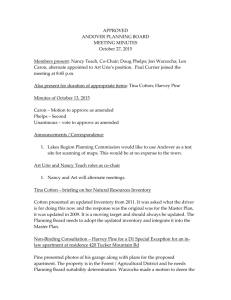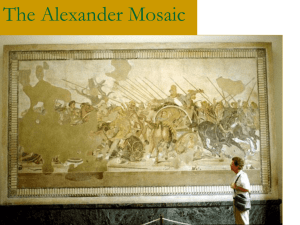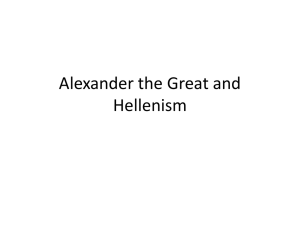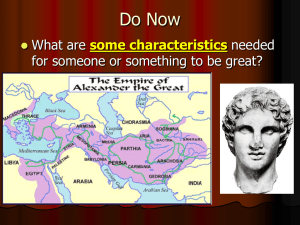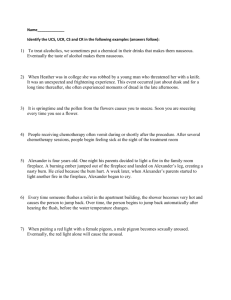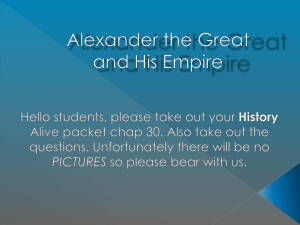Transcript
advertisement
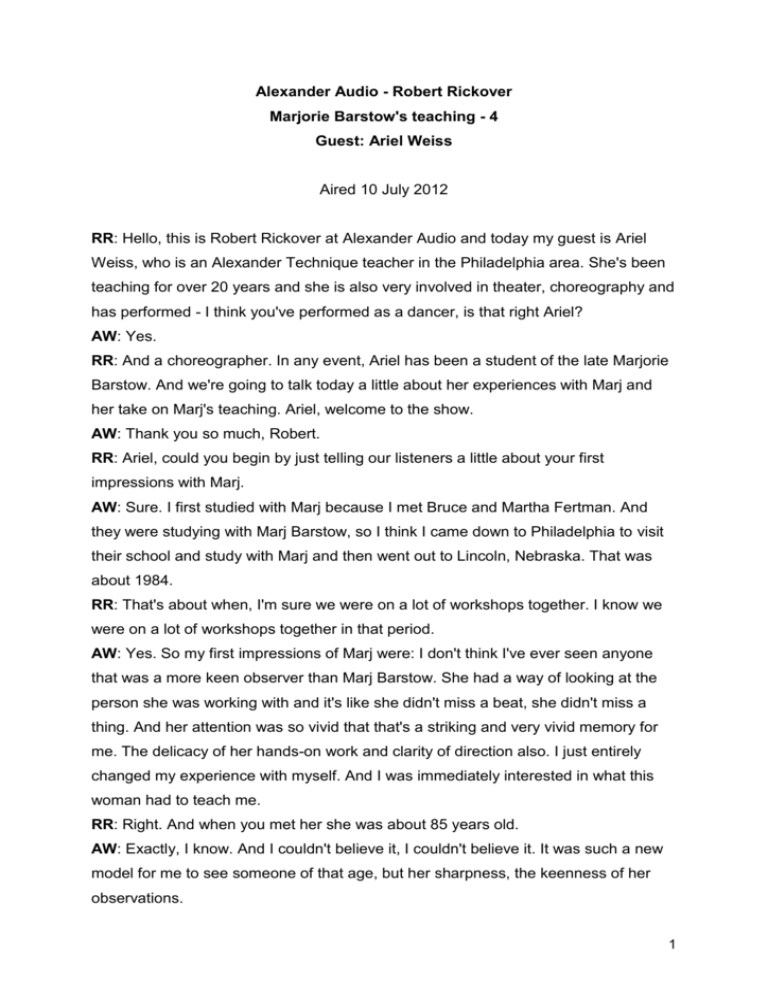
Alexander Audio - Robert Rickover Marjorie Barstow's teaching - 4 Guest: Ariel Weiss Aired 10 July 2012 RR: Hello, this is Robert Rickover at Alexander Audio and today my guest is Ariel Weiss, who is an Alexander Technique teacher in the Philadelphia area. She's been teaching for over 20 years and she is also very involved in theater, choreography and has performed - I think you've performed as a dancer, is that right Ariel? AW: Yes. RR: And a choreographer. In any event, Ariel has been a student of the late Marjorie Barstow. And we're going to talk today a little about her experiences with Marj and her take on Marj's teaching. Ariel, welcome to the show. AW: Thank you so much, Robert. RR: Ariel, could you begin by just telling our listeners a little about your first impressions with Marj. AW: Sure. I first studied with Marj because I met Bruce and Martha Fertman. And they were studying with Marj Barstow, so I think I came down to Philadelphia to visit their school and study with Marj and then went out to Lincoln, Nebraska. That was about 1984. RR: That's about when, I'm sure we were on a lot of workshops together. I know we were on a lot of workshops together in that period. AW: Yes. So my first impressions of Marj were: I don't think I've ever seen anyone that was a more keen observer than Marj Barstow. She had a way of looking at the person she was working with and it's like she didn't miss a beat, she didn't miss a thing. And her attention was so vivid that that's a striking and very vivid memory for me. The delicacy of her hands-on work and clarity of direction also. I just entirely changed my experience with myself. And I was immediately interested in what this woman had to teach me. RR: Right. And when you met her she was about 85 years old. AW: Exactly, I know. And I couldn't believe it, I couldn't believe it. It was such a new model for me to see someone of that age, but her sharpness, the keenness of her observations. 1 RR: And what was your take on the group dynamics there, because I think when you were there in the mid-80s that was when the size of the summer workshop groups in any case were getting pretty big. It could easily be 100 people in the same room with her. AW: Yes. RR: What's your take on how she dealt with that? Cause that was certainly out of the norm for Alexander Technique teaching then and today, for that matter. AW: Right. Well, of course I did not know that because that really was my first - well, it wasn't my exactly first exposure but it really was my first immersion in the work. My impression of that is that Marj held the attention of that room, and what she demanded of us was to engage in observation of ourselves and observation of each other. So that, because you weren't getting a turn very often - as a matter of fact I kind of remember counting one summer 80 or 90 people and realizing it was going to take about 3 days to get a turn with Marj. You know, it took some patience to wait for that turn. But what happened was: you did an awful lot of learning while you waited for your turn, because it wasn't all about having someone's hands on you, it was about engaging in the thinking process, engaging in observation and engaging in experimentation. And I think that's quite different than how many people come to learn Alexander Technique. RR: Although I think you know when you said it might take 2 or 3 days to get a turn, I think some of us were maybe a little more adept at narrowing those odds. AW: Well, we worked with other teachers, so it wasn't 2 or 3 days to get a... RR: And also she would do little things where people would kind of walk past her and she would give them a little quick mini Alexander lesson. I remember those groups of 80, 90, 100 people and I think I usually managed to grab 2 or 3 little turns with her but some people were more, I guess you could say skilled at the system, they could get a little more work that way. But you're absolutely right, a lot of the learning was taking place while Marj was working with somebody else, but you were observing and so on. And I can remember once sitting on a couch in one of those large groups and suddenly noticing that I was tightening my neck for the first time, I had never really appreciated that before, and just kind of undid it right there on the spot. I'm sure you've had experiences like that too. AW: Lovely. Well, I'm also having a memory of going and visiting the Carrington school when I was visiting in London once and I remember being quite taken aback 2 because after students got a turn with Dylis or Walter they would very calmly go off and do some lying down work, some semi-supine, and no one was watching Dylis and Walter work with other students. RR: Mmh, yeah, that's right. AW: And I was so taken aback because I was really wanting to watch them work and knew that I would gather so much from observing. And I felt rather out of place because I almost felt like what I was doing was rude because it was clearly a very different learning culture. RR: Apart from the fact that Marj had this facility for in a sense working with and teaching quite large groups of people, from what you've seen of other Alexander teaching styles out there what else distinguishes her approach in your mind from other strands? AW: Well, for me there are several things. One is that I think because Marj did not feel beholden to doing it just as she was taught, Marj was an innovator. Marj was what I would call riffing on a theme, that's not what Marj would have said, but she was taking those principles and putting them into practice. And she was quite - well, what do I wanna say here - she was quite strict that you apply those principles but her ability to play with the form of it and her willingness to experiment was really quite inspirational and so her teaching changed all the time is what I'm trying to say. The language that she used or how she would even organize the group. I remember at one time she got very interested in that we all work on our speaking. And so we did quite a bit of nursery rhymes that summer. So she was constantly looking for a way for us to explore our own observations of our use. This willingness to keep experimenting and engage her students. To me Marj was all about a very insistent having people engange in their thinking process, that it wasn't just something you did with your body, that it was very much about directing your awareness and directing your thinking. RR: She used to say "this is all mindwork". And she also had a phrase that she used from time to time, you might have heard it, that she thought that someday there would be a sort of a science of human movement in which Alexander's ideas would play a big part. But you're right, I mean she definitely didn't have a passive student, she wanted people who were gonna be thinking, observing, practicing, experimenting, that was a major theme of her teaching. But as you also say it was very very grounded in the principles and there's no one around who read Alexander's 3 books more frequently than she did and would refer to them. I don't know how many times we had to read chapter 1 of Use of the Self, I mean that would be a great way to get a turn, saying "Hey Marj, I'd like to read something of Alexander", that would be a perfect way to get some attention from her in a workshop. AW: Yes, you would definitely get a turn if you talked about Alexander's writings. RR: Exactly, yeah, exactly. AW: Yes. Also her light-heartedness and humour and real delight. You know, there was always this sense that as people freed up their downward pull, it really was liberating. And you know I just remember being at those workshops and thinking nothing was more beautiful than seeing people come into their Primary Pattern and Marj really approached the work with this light-hearted, straightforward practicality. Light-hearted, straightforward and practical. You knew that there was always more delicacy that could be available, but for me, I was so fortunate to find Marj in my twenties as a very young and a very very pushy dancer, that I got that. I could understand that I could always get more delicate. I understood what it was I was aiming for, whereas my previous exposure to Alexander Technique so emphasized non-doing which is a perfectly valid way to teach the work but it really was not a good fit for me at that age and from my background. I didn't really know how to do that, how to not do that. I didn't really know how to not do that. I didn't really understand what I was aiming for. RR: Yeah, you know, it might be worthwhile talking a little more about that because a classic Alexander Technique concept is non-doing. But of course if you're thinking, there is a physical correlate to your thoughts. You cannot have a thought without some muscular activity. And my sense, and I'd be interested to see how you see this, is that the sort of traditional way of teaching, as you say, will emphasize "just think it, just think it" and that is a valid approach, whereas Marj tended to emphasize the, if you want to call it the minute movement part of the equation, and she would ask you to, for example, move your head very delicately away from your torso, that was kind of a common phrase that she might use. And of course a lot of traditionally trained teachers and certainly when I first encountered that I'd already been on a training course I was a little shocked by that because it went against what I had been taught. But once I saw how she applied that and I saw how well it worked I could see that she was kind of approaching that whole thought affects movement, movement is 4 always gonna be related to a thought in some way, she was approaching it a bit more in the opposite direction, I would say, than most Alexander teachers. AW: Yes. RR: And for you that worked a lot better. AW: It was essential, it really was the essential ingredient that kind of captured my interest and my motivation to study this work. You know, Jeremy Chance spoke so eloquently about this very subject and teaching paradigms and comparing them and he really helped me kind of understand in a context what my own experience had been: that Marj really looked at inihibition in a proactive way. And I remember her saying quite specifically: "You can't be doing this (as she demonstred a slump) as you're doing this (as she demonstrated freeing herself)." She said: "You can't do them at the same time. Sometimes we're quite crafty going back and forth, but you really can't do them both simultaneously." RR: Yeah, yeah. And I think as kind of another way of pointing out the difference in her, if you wanna call it, her teaching paradigm from many other teachers' paradigms: I can remember in England going to a talk by Marjorie Barlow, who of course was a very different Marjorie but a really excellent teacher in the more traditional mode, and when she was asked about inhibition, her analogy was the gearshift of a car, standard transmission gearshift, where, if you're gonna go from first gear into reverse, you do need to pass through neutral, and for her that neutral or that doing nothing, I guess, was inhibition. I think that's a valid model but I think the Marj model which she did not herself articulate quite like this was again a car analogy: you're driving down a highway and you realize that you're going in the wrong direction, you passed where you wanted to go, and you pull over to the side and it's possible you might come to a complete stop or it's possible if there's no traffic on the road you might pull over and do a U-turn and never stop, but you would be changing direction completely. So I guess you could say it's a more dynamic model of what inhibition is all about, or inhibition as movement maybe would be another way to say it. AW: Yes, yes. And that I think is also... You're leading us up to another important distinction about Marj's teaching: because she worked with people, what we would call activity work, she met people in the activity of their lives, so in other words, instead of bringing them to the traditional forms of chair work or getting in and out of a chair - she did those too, of course - but because she welcomed us looking at our use inside of things we were quite habituated in, so for me that was dancing and 5 other people that was many other interesting activities, by working with us in activity you could not turn Primary Pattern into a correct position. It was not possible. She made it so apparent that what we were after was not to fix ourselves in some you know very fancy cheated stiffened position. That whole idea of dynamic thought leading to dynamic movement I think she really brought to life by the way she worked with us all. RR: Yeah, you know, again comparing that with the traditional approach which as you say would have various procedures like chair work and stuff about hands on back of chair and all that sort of stuff, lunge, monkey, a lot of teachers would , their approach to teaching somebody would be to confine their teaching to those few procedures, they would become very good at teaching those procedures, and that can be an extremely effective way to teach the Technique with the right teacher. The assumption, though, was that that would carry over into a student's other activities, and sometimes it does, often it does, but I've certainly seen lots of examples of, let's just say musicians, cause I do work a lot with musicians that will have, you know, many many chair work, table work etc. lessons, and it'll be quite a shock when they come to me and I say "Well, bring your violin, let's see what you do when you play". It's almost like "Oh, actually I guess I could apply this to my music". AW: Oh, absolutely. RR: You know, from my point of view, a new student who came who is a musician and certainly the way Marj would approach it, let's get the fiddle out and start playing, let's see what you do, I mean that would be the first thing she would probably do with a new musician in the group. AW: Yes, and I work with world-class musicians at the Curtis Institute of Music and I spend a great deal of time having my students learn about what they're doing as they bring that instrument up because so much goes on. These students have been practicing thousands upon thousands upon thousands of hours, and so those habits are strong and quite invisible to them. And so, yes, if they're working and having table work you could be making an impact on their use and functioning but they need to be able to apply that to that activity. It's essential. RR: I'm sure there are some people who would just naturally think to apply it but I wouldn't wanna count on that with a student. AW: Well, it's not even whether they would think to. For me, it's that the specificity of how they're responding to that stimulus. I mean I can relate this to my own 6 experience that I would bring Marj, you know, particular dance phrases either from choreography or performing of from kind of warm-up exercises, things that I was very familiar with. When I would return to that set choreography in a class or in a performance there was this very kind of vivid muscle memory that I'd had a new experience of that very patterned movement behavior in a new way. And it was much easier in my own experimentation of directing my own movement once I'd kind of altered the anchoring of those movement phrases with all that extra tension and misuse. RR: Yeah. And, you know, this isn't really a show about music but another example that I've noticed and I think this could be applied to a lot of other activities: one of the things I got from Marj, of course as you said earlier she really emphasized your developing very keen observational skills, and when I started working with musicians one of the things I noticed was that when they would go over to open their case or even just think about playing all kinds of weird patterns would often come into play that they were certainly not aware of. And I could see that pretty clearly because Marj taught us to observe those kinds of things, and so when I work with a musician I wanna know what happens when they decide to play and begin that walk over to the case to open it. AW: Exactly. RR: Cause a lot happens then and a lot that will affect the subsequent playing. AW: Yes, I'm glad you talk about that because I think really one of the brilliances of Marj's teaching was she really had us notice the critical moment. That from all that very careful observation of ourselves and also in that group you could see it, you could really start to see it. And I'm a big advocate that if I can get my students to look around in the world and watch other people's patterns of misuse and see that critical moment it will help them observe it in themselves. RR: Absolutely. I agree 100 % . I also tell my students that once they have a hint about what we're doing I say go and observe people and not to be critical or judgmental but whatever you see ask yourself, am I doing that or the opposite or not doing that, be very interested in the people around you because they can be some of your best teachers if you use it that way. Is there anything else that we haven't covered that you'd like to talk about about Marj? AW: Well, I think I just wanted to talk a little bit more about kind of her attitude towards the work and this kind of, and we're touching upon it now in what we're 7 talking about, that Marj was so curious, she really never stopped learning, you could see her exploring actively her own sense of herself and movement and her students. And this kind of active curiosity and also light-heartedness, that, you know, if someone started getting very despondent, which, oh, how often we did, and how disappointed we were in our own kind of performance. She really was quite insistent that we not take ourselves too seriously and that this was really something... she kept it very practical, so it was always of course you could pay attention a bit more and of course you could be a bit more delicate and of course you could figure out which direction was away from your body. It didn't need to be quite so introspective and cutoff from the world, it didn't need to be overly serious, and that that harshness of thinking would only bring about a kind of stiffness in our own movement. RR: And, you know, she was certainly the most in-the-moment person I have ever met in my life. I mean, she was right there whenever you were with her. I mean, she was not one to dwell much on the past, it was kind of boring to her to talk about, you know, we tried to get her to say who she liked better, A.R. Alexander or F.M. Alexander, cause she worked with both of them. You know, she would have none of that. And she wasn't really that interested in figuring out what was gonna happen in the future. I mean, she was really grounded in the moment I would say more than anyone I've ever encountered. And I think that is related to what you just said: for her life was all about process. AW: And actually you're helping me kind of understand too that part of what I cherished about Marj's teaching was this real practicality of it. Marj really liked to help people do what they were doing a bit better. You know that it wasn't about a judgment, it wasn't that good use was better and people with good use were better. It was really that this is what we do because it works a bit better, you breathe a bit better, you sing a bit better, you balance a bit better. And I think that's quite key actually, that, you know, I often tell my students about Marj being very clear with us that pulling down was really just part of our flexibility. That the minute we started trying to avoid our slump and stiffen ourselves we weren't doing what Mr. Alexander had in mind at all, and that really that was just part of our flexibility as well, and that the point wasn't to never do that, it was to have the freedom to go in and out as we saw fit. RR: Right. She would sometimes say "Well, you know, sometimes I just like to go into a little slump", and then she'd go into this very delicate slump and then she 8 would say "And after a while, you know, I might decide I don't wanna stay here anymore". But I mean it was okay to slump, she didn't... And I think that what you just talked about really points to I guess you could say the classic put-down that sometimes people might have of let's say traditionally trained teachers that they are a little stiff, trying to be right, not wanting to - if you're an Alexander Technique teacher you don't wanna sort of slump in public because then your peers will all say "Look, that teacher slumping can't be any good", and you know their nickname is Alexandroids. Now, on the other hand of course they looking at Marj teachers could say "Oh, they're just slumping sometimes, that's not good". But yeah, I don't think she was ever really about being right so much... AW: Exactly. That's right. RR: ...as simply making an improvement. AW: It was about the flexibility, I mean I think that's what I continue to kind of learn from her teaching and remind myself of that, because you know we bring our pushy habits to trying to be right. RR: And that idea of not being right, she would apply to her own teaching. I mean often at the end of a workshop I'd be talking with her and she said "Well, you know, I think I did a pretty good job this time, I did some things differently", you know, and she would experiment, she was always experimenting. And the way she taught in the early 90s for example was very different than when she taught 10 years earlier. There was carry-over but you know every time you'd come out to Lincoln to study with her it would be a little different. She would have thought of some... she'd have some new ideas, and sometimes in class she'd come in in the morning and she said "Oh, last night I spent a lot of time thinking about how I could have explained that better to you", that was her approach to the teaching. And also in a way connected with it in her classes you would have no idea if you just dropped in from outer space you wouldn't know who was a trained Alexander teacher and who was someone who had just walked in off the street. You would have no way of determining it other than some of the teachers might have been a little stiffer and also wouldn't necessarily be real quick to think of an activity when she said who wants to do something. AW: Yeah, I think with Marj what you got was a real appreciation that these principles were a living breathing form to be applied and that it wasn't some canon that you had to repeat just so. But that you know if Mr. Alexander was stil around he would still be exploring and innovating. 9 RR: Absolutely. And he did, I mean his career was marked by many changes in his teaching style, in Frank Pierce Jones's book he talks about some of those. So my sense of Marj was that she was doing exactly what Alexander hoped his teachers that he trained would do, and he saw himself and he even writes about this as being, his work being a kind of a signpost for future developments and I think he even said somewhere "my work is just the beginning". He never saw his sets of procedures for example the ways in which he taught as in any way cast in stone, they were just what worked for him at that time. Anything else you wanna add before we come to a close? AW: I can't think of anything just now but I so appreciate your including me in this conversation. RR: Oh, it's always a pleasure talking about Marj with someone who has also had experience with her. So, my guest today has been Ariel Weiss, an Alexander teacher in the Philadelphia area, and we've been talking about the late Marjorie Barstow. You can learn more about her teaching at a website set up for her, it's marjoriebarstow.com, and we'll put a link to it by the interview, but Marjorie is spelled M A R J O R I E and her last name is B A R S T O W. So, Ariel, thank you so much for being on the show today. AW: Thanks, Robert. Transcribed by Saskia Breitling 10
